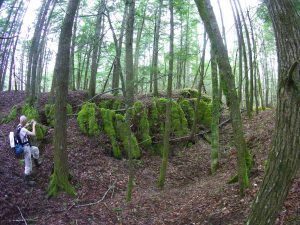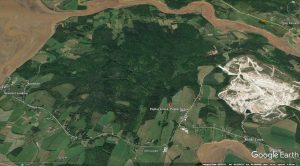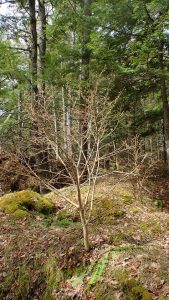Then the downturn in U.S. housing dampened the market and the mine was closed in early 2011. Now even the Keep Out signs are gone from the entrance to the old mine.
Recently, a commentary by Lawrence Solomon in the Financial Post touted Trump as Canada’s most effective environmentalist. Trump, he says, is doing us a favour by demanding we stop subsidizing the removal of our trees.
British Columbia, Canada’s biggest lumber exporter by far, sells most of its trees to a handful of major logging companies, based on a bureaucratic formula that lets the companies obtain wood, much of it from old-growth forest, for as little as 25 cents per cubic metre. Picture a telephone pole and you’re picturing one cubic metre of wood. Picture a long logging truck piled high with logs and you’re looking at 35 to 40 cubic metres of wood, or $9 to $10 worth of wood…Last year, B.C. fetched that 25-cent rate on one-third of its total harvest of 21.2-million cubic metres. In exchange for that levelling of provincial forest, the B.C. treasury obtained a paltry $5.3 million.
Solomon maintains the B.C. government lets its trees go for next-to-nothing to salvage rural jobs but that “this winning short-term strategy for politicians has been a long-term loser for just about everyone else. Over the last decade, B.C.’s forest industry has lost more than 22,000 jobs; over the last two decades, close to 100 mills have gone under. More mills and more jobs are slated to disappear as more regions get logged out and their communities get rubbed out.”
Solomon says B.C would be better off with private owners such as the Schleifenbaums, owners of the 40,000-hectare Haliburton Forest and Wild Life Reserve in Ontario who turned what was a “logged over mess” in 1962 to a thriving large employer today with a diverse set of operations including a sawmill fed by six logging crews, a camping operation, a 300-kilometre hiking trail, a wood shop produces paddles, salad bowls and other wood products, and the lands are popular with fishers, mountain bikers, snowmobilers, even astronmers… most or all, it seems, not dependent on exports. That description reminded me of Taylor Lumber Co’s Middle Musquodoboit operations, albeit those are on a much smaller scale.Solomon also notes that “the privately owned forests of Nova Scotia have been exempted from the softwood lumber disputes, and although the Trump administration has temporarily slapped Nova Scotia’s woodlots with tariffs, the U.S. lumber lobby, siding with Nova Scotia, has recommended their removal.” Nova Scotia sets its Crown stumpage fees based on an independent assessment of market values, and those come in at the highest in Canada. It’s largely on that basis that N.S. has been excluded from the U.S. tariffs in the past and hopes to once again.
So, I ask, how can Nova Scotia harvesters afford those fees and still harvest wood competitively? The answer I got from one person quite knowledgable about it all: “the high fees are designed for the big clearcutters; clearcutting is the only way they can make a profit”. So is that it: large-scale clearcutting, most of it sold for fibre with some logs coming off going to sawmills probably for less cost to sawmills than if the same logs had to be obtained by selection cutting? Is that what keeps the bigger sawmills happy with clearcutting on 55 year rotations? Is there still enough forest cut more than 55 years ago to keep the sawmills happy for now?Following Mr. Solomon, supposing N.S. does get its exemption and B.C. doesn’t? One possibility as Robert Taylor of Taylor Lumber surmised: B.C. lumber floods the N.S. market, and the local producers and marketers like himself hit hard times; perhaps that would further dampen profitability of clearcutting, leading to more conservative harvesting of forests.

Photographing unusual moss covered “gypsum chimneys” Apr 29, 2017. Could the long term tourist potential of forested gypsum karst on the Avon Peninsula be more valuable to Nova Scotia than short term gain from gypsum exports?
Click on image for larger version.
There are other options, such as “cutting less and doing more” with wood, and pursuing carbon credits and other non-timber forest products that can support rural economies AND allow our forest ecosystems to begin to recover from decades, even centuries of mis-use. We just need to start seriously pursuing them, with or without Mr. Trump doing his thing south of the border.
——–
Tip of the Hat to The Tree Frog News (May 1, 2017) for the Solomon piece.




